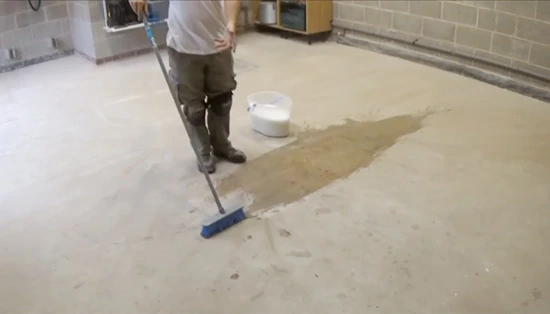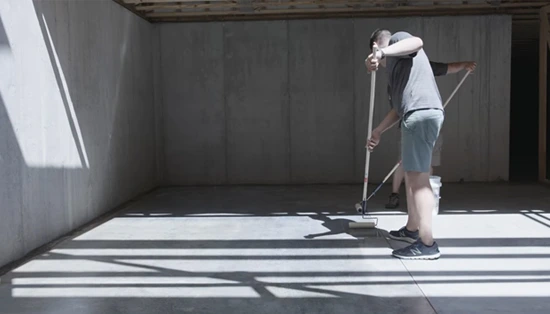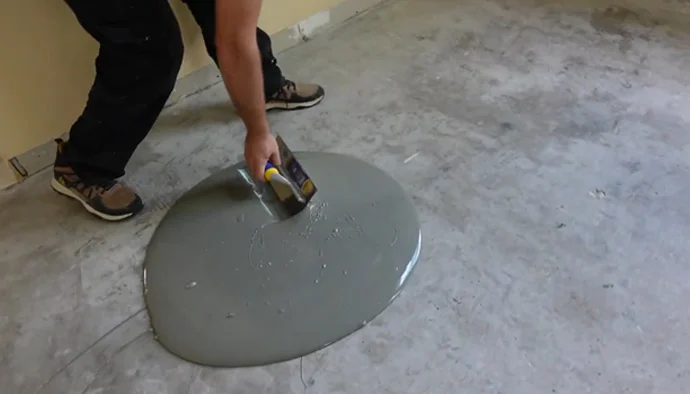Last Updated on February 6, 2023
If you’re looking to install carpet over a concrete floor, it is important to make sure that the surface of the concrete is properly sealed before laying down the carpet. It’s essential to seal the floor in order to protect it from moisture, dirt, and other elements that can damage the integrity of your flooring system.
Sealing your concrete floor before laying down carpet helps ensure its durability and longevity, while also giving it an attractive finish.
In this blog post, we’ll discuss why sealing your concrete floor is important and discuss different types of materials used in making concrete floors, how each material affects the integrity and durability of the flooring, what climate changes do to unsealed concrete floors, and how to prepare for sealing your floor before you install carpeting over it.
Composition of Concrete Floors
Different Types of Materials Used in Making Concrete Floors
It is important to seal concrete floors before laying carpet, as the type and quality of materials used in making a concrete floor can greatly affect its durability. Many concrete floors are composed of cement, water, and sand or gravel, but there may also be other materials such as fly ash, slag cement (ground granulated blast furnace slag), chemical admixtures, fibers, coloring agents, or pigments.
The type and amount of each material will determine how porous the floor is and how much protection it needs from spills and moisture. Sealing a concrete floor with a suitable sealer can protect against staining from liquids and chemicals, as well as damage caused by frequent foot traffic.
How Each Material Affects the Integrity and Durability of the Flooring
The type of materials used in making a concrete floor will also determine its strength, integrity, and durability. For example, if the mix contains too much water or not enough sand or gravel then it may not be durable enough for use in industrial or commercial settings that require frequent foot traffic or heavy equipment use.
Additionally, certain types of aggregates (such as quartzite) are particularly strong but more expensive than others so their use should be carefully considered when deciding whether or not to seal a concrete floor before laying carpet on top of it.
What Climate Changes Do to Unsealed Concrete Floors
Climate changes can have an even greater impact on unsealed concrete floors than those that are sealed properly since they will be more prone to cracking due to cold temperatures and expansion/contraction caused by extreme heat variations throughout the year.
Sealing a concrete floor with an appropriate sealer allows for some flexibility during these climate changes while still providing protection against water penetration which could cause further deterioration over time if left unsealed.
Furthermore, sealing provides additional protection against staining from liquids such as oils and grease that could otherwise cause permanent marks on an unsealed surface if tracked across it multiple times.
Preparing to Seal Your Flooring

Cleaning and Removing Old Paint and Other Debris From the Surface of The Floor
When preparing to seal a concrete floor before laying carpet, it is important to first thoroughly clean the surface and remove any old paint or debris. This should be done with a high-pressure washer that is strong enough to remove all dirt, dust, and grime from the surface.
If there are areas of old paint on the concrete, they should be scraped away using a special paint scraper tool before applying the sealant.
Additionally, it is important to use a mild detergent mixed with warm water when cleaning the concrete so that it can be completely free of any residue that could affect how well the sealant will adhere to it later on.
Checking for Cracks or Uneven Areas in The Surface and Taking Necessary Repairs Before Applying a Sealant
Before applying any kind of sealant to a concrete floor before laying carpet, it is also important to inspect for any cracks or uneven areas in its surface. These can be caused by excess moisture seeping into the concrete, weather changes, or even just normal wear and tear.
If these cracks are not treated before applying a sealant, they will only become more pronounced over time as the sealant dries on top of them. In order to fix these issues prior to sealing the concrete floor, many recommend using an epoxy filler designed specifically for masonry repair jobs like this one.
Not only does this fill any gaps or holes in the surface quickly and effectively but it also helps ensure that your new sealant will adhere properly when applied afterwards.
Selecting an Appropriate Type of Sealant Based On The Kind of Material Used To Make The Floor, Its Age And Condition, As Well As Its Location In The Home
The type of sealant you choose for your concrete floor before laying carpet must be appropriate for both its material type as well as its age and condition.
For example, if your concrete is older than fifteen years old then you should opt for a penetrating sealer rather than an acrylic film-forming one since the latter may cause more harm than good if used on aged surfaces such as yours.
Additionally, you must take into consideration where your home’s location is due to extreme temperatures or humidity levels which could necessitate changing up your choice in sealants accordingly.
For instance, if you live somewhere that experiences both very hot summers and cold winters then an elastomeric membrane type might work best while people living in wetter climates may want to look into silicone-based ones instead as they are able to withstand greater amounts of moisture without breaking down over time like other types would likely do eventually under similar conditions.
Allowing Enough Time For The Sealant To Properly Set On The Floor Before Laying Carpet Over It
Finally, once all necessary steps have been taken prior to sealing your concrete floor before laying carpet such as cleaning it thoroughly and filling in any cracks or other damage present on its surface before beginning application; allowing enough time for the chosen sealer product to be used properly afterwards is key too .
This process usually takes at least 24 hours from start to finish depending on what kind was used so allowing yourself at least this much time between finishing up application and starting installation work on your new carpet helps ensure everything stays looking beautiful in both form and function after everything has been completed!
Benefits Of Sealing Your Floor Before You Install Carpeting Over it
Reducing Chance Of Water And Moisture Damage To Your Carpet By Preventing Water Penetration Through The Porous Surface Of The Unsealed Concrete:
Sealing concrete floors before laying carpet is an essential step for any homeowner who wants to ensure that their floor remains safe and protected from water and moisture damage.
Without a sealant, the porous surface of unsealed concrete can easily allow water and other liquids to seep through and potentially cause costly damage to your carpet or underlying flooring.
Not only can this type of damage be unsightly, but it can also lead to mold growth and structural damage if left untreated. Sealing your concrete floor before laying carpet is an effective way to reduce the chances of water-related issues affecting your home by providing an extra layer of protection against liquids entering the subfloor.
Additionally, sealing concrete prevents staining due to oils, dirt, and dust constantly being tracked in, helping your carpets look cleaner for longer.
Increasing Durability Of Carpet By Providing An Extra Layer Of Protection Between It And Any Possible Damage Caused By Climate Conditions, Such As High Humidity Or Extreme Temperatures:
The harsh climate conditions present in many homes can take a serious toll on carpets that are not properly protected. In high humidity areas, moisture will seep into the fibers of the carpet causing them to expand and contract as temperatures fluctuate which leads to an unsightly wave pattern appearing in the material over time.
On top of this, extreme temperatures inside or outside your home will cause the carpet fibers to become brittle or crunchy so they can easily break apart if stepped on or walked over with any amount of force.
Sealing concrete floors with a quality sealer before installing carpet helps create an additional protective barrier between your carpeting and any potential damages caused by changing weather conditions such as high humidity or extreme temperatures which will extend the life-span of your carpets significantly.
Enhancing Aesthetic Appeal Of Your Home by Creating A Smoother Finish For Any Type Of Carpet Installed on Top:
When it comes to creating a beautiful living space one element that you should consider when installing new carpet is how it interacts with the underlying surface it is installed upon whose level must be completely even across its surface in order for it to look its best once completed.
While doing so may seem simple enough, unfortunately not all surfaces are created equal with some having cracks or uneven edges that may appear after installation regardless of how carefully you lay down each piece making them stand out from each other rather than blending together seamlessly like intended upon completion.
Fortunately however sealing your concrete floor prior to installation is an effective way to create a smoother finish by filling out gaps or uneven spots while also preventing dust build up, keeping your new floors looking better for longer while also enhancing its overall aesthetic appeal significantly as well!
How long should I wait after sealing the concrete floor before installing the carpeting?

Generally speaking, it is best to wait at least 24 hours after sealing your concrete floor before laying down carpeting. This allows the sealer to fully dry and cure which will ensure it forms a strong bond with your concrete floor.
It also gives you time to check if any additional sealing or other preparation steps may be needed prior to carpet installation.
Does the type of carpet affect whether or not I need to seal the concrete floor beforehand?
Yes, the type of carpet can affect whether or not you need to seal your concrete floor prior to installation. Certain carpets are more prone to staining and absorbing spills, so it is important that you properly seal your concrete floor in order for these carpets to have a chance at lasting longer.
On the other hand, certain carpets are designed in such a way that they do not require a sealed surface beneath them and can be installed directly on top of an untreated concrete surface. It is therefore important that you determine what type of carpet you are planning on installing in order to decide if pre-sealing is necessary.
Are there any safety measures I should take when sealing a concrete floor prior to laying down carpets?
When sealing a concrete floor prior to laying down carpets, it is important that you take certain safety precautions in order to ensure your own health and safety as well as that of others around you.
First and foremost, make sure that you wear adequate protective clothing such as gloves and face masks while applying the sealer in order to avoid skin contact with potentially hazardous chemicals, as well as inhaling any harmful fumes emitted by the sealer itself.
Additionally, keep children and pets away from the area while applying sealer as their sensitive lungs could be affected by inhaling too much of its fumes.
Finally, always remember to read all instructions related to handling any chemical products carefully in order to avoid any accidents or injuries caused by improper use of these materials.
To Sum Things Up
To conclude, when it comes to installing carpet over a concrete floor, proper sealing should not be overlooked. Sealing your concrete floor provides protection from moisture and other elements that can cause damage to your flooring system.
Different types of materials are used in making concrete floors; each material affects the overall integrity and durability of the flooring. Climate changes can affect unsealed concrete floors as well.
Preparing for sealing includes cleaning and removing old paint or debris from the surface and checking for any cracks or uneven areas prior to sealing. By taking these steps prior to installing carpet on a concrete surface, you can help ensure that your floors will last longer and look their best for years to come.



